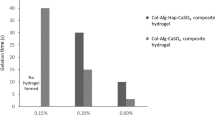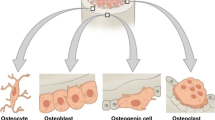Abstract
Introduction
Superporous hydroxyapatite (HAp-S) is a novel bone substitute that contains three-dimensionally interconnected macropores with micropores, which stimulate bone ingrowth into the material.
Method
We investigated the in vivo behaviour of HAp-S by comparing its bioactivity and biomechanical properties with beta-tricalcium phosphates (β-TCP). HAp-S or β-TCP was implanted in the lateral femoral condyle of rabbits. In vivo bioactivity of each material, including bone ingrowth and material resorption, was quantitatively evaluated by micro-CT and the ultimate compressive strength of the bone–material composite was also measured. Micro-CT showed that bone ingrowth in the HAp-S group significantly increased over time, while no significant increase was observed after 8 weeks in the β-TCP group.
Results
Although both materials showed gradual material resorption, β-TCP resorption was significantly greater than HAp-S. The ultimate compressive strength in the HAp-S group significantly increased over time up to six times its original value, while there was no significant increase in the β-TCP group. These results show that HAp-S resorption is concurrent with bone ingrowth, resulting in increasing compressive strength over 12 weeks. On the other hand, β-TCP resorption is fast but unaccompanied by bone ingrowth; consequently, it remains relatively fragile at least in the early period after implantation. Although these highly porous materials themselves are structurally and mechanically similar, there are significant differences in in vivo behaviour depending on the material composition.
Conclusion
These findings should be kept in mind when choosing the highly porous ceramics.







Similar content being viewed by others
References
Ransford AO, Morley T, Edgar MA, Webb P, Passuti N, Chopin D, Morin C, Michel F, Garin C, Pries D (1998) Synthetic porous ceramic compared with autograft in scoliosis surgery: a prospective, randomized study of 341 patients. J Bone Joint Surg Br 80:13–18
Damien CJ, Parsons JR (1991) Bone graft and bone graft substitutes: a review of current technology and applications. J Appl Biomater 2:187–208
Brantigan JW, Cunningham BW, Warden K, McAfee PC, Steffee AD (1993) Compression strength of donor bone for posterior lumbar interbody fusion. Spine 18:1213–1221
Wang M (2003) Developing bioactive composite materials for tissue replacement. Biomaterials 24:2133–2151
Bucholz RW, Carlton A, Holmes R (1989) Interporous hydroxyapatite as a bone graft substitute in tibial plateau fractures. Clin Orthop Relat Res 240:53–62
Nakano K, Harata S, Suetsuna F, Araki T, Itoh J (1992) Spinous process-splitting laminoplasty using hydroxyapatite spinous process spacer. Spine 17:S41–S43 (Phila Pa 19760)
Waite PD, Morawetz RB, Zeiger HE, Pincock JL (1989) Reconstruction of cranial defects with porous hydroxylapatite blocks. Neurosurg 25:214–217
Ayers RA, Simske SJ, Nunes CR, Wolford LM (1998) Long-term bone ingrowth and residual microhardness of porous block hydroxyapatite implants in humans. J Oral Maxillofac Surg 56:297–1301
Sakamoto M, Nakasu M, Matsumoto T, Okihana H (2007) Development of superporous hydroxyapatites and their examination with a culture of primary rat osteoblasts. J Biomed Mater Res A 82:38–42
Hulbert SF, Young FA, Mathews RS, Klawitter JJ, Talbert CD, Stelling FH (1970) Potential of ceramic materials as permanently implantable skeletal prostheses. J Biomed Mater Res. 4(3):433–456
Tsuruga E, Takita H, Itoh H, Wakisaka Y, Kuboki Y (1997) Pore size of porous hydroxyapatite as the cell-substratum controls BMP-induced osteogenesis. J Biochem 121:317–324
Itälä AI, Ylänen HO, Ekholm C, Karlsson KH, Aro HT (2001) Pore diameter of more than 100 micron is not requisite for bone ingrowth in rabbits. J Biomed Mater Res 58:679–683
Bohner M, Baumgart F (2004) Theoretical model to determine the effects of geometrical factors on the resorption of calcium phosphate bone substitutes. Biomaterials 25:3569–3582
Galois L, Mainard D (2004) Bone ingrowth into two porous ceramics with different pore sizes: an experimental study. Acta Orthop Belg 70:598–603
Miño-Fariña N, Muñoz-Guzón F, López-Peña M, Ginebra MP, Del Valle-Fresno S, Ayala D, González-Cantalapiedra A (2009) Quantitative analysis of the resorption and osteoconduction of a macroporous calcium phosphate bone cement for the repair of a critical size defect in the femoral condyle. Vet J 179:264–272
Fini M, Motta A, Torricelli P, Giavaresi G, Nicoli Aldini N, Tschon M, Giardino R, Migliaresi C (2005) The healing of confined critical size cancellous defects in the presence of silk fibroin hydrogel. Biomaterials 26:3527–3536
Soffer E, Ouhayoun JP, Meunier A, Anagnostou F (2006) Effects of autologous platelet lysates on ceramic particle resorption and new bone formation in critical size defects: the role of anatomical sites. J Biomed Mater Res B 79:86–94
He H, Yan W, Chen G, Lu Z (2008) Acceleration of de novo bone formation with a novel bioabsorbable film: a histomorphometric study in vivo. J Oral Pathol Med 37:378–382
Pelekanos S, Koumanou M, Koutayas SO (2009) Micro-CT evaluation of marginal fit of different In-Ceram alumina copings. Eur J Esthet Dent 4:278–292
Chang BS, Lee CK, Hong KS, Youn HJ, Ryu HS, Chung SS, Park KW (2000) Osteoconduction at porous hydoroxyapatite with various pore configurations. Biomaterials 21:1291–1298
Gatti AM, Zaffe D, Poli GP (1990) Behaviour of tricalcium phosphate and hydroxyapatite granules in sheep bone defects. Biomaterials 11:513–517
Shimazaki K, Mooney V (1985) Comparative study of porous hydroxyapatite and tricalcium phosphate as bone substitute. J Orthop Res 3:301–310
Bucholz RW, Carlton A, Holmes RE (1987) Hydroxyapatite and tricalcium phosphate bone graft substitutes. Orthop Clin North Am 18:323–334
Eggli PS, Müller W, Schenk RK (1988) Porous hydroxyapatite and tricalcium phosphate cylinders with two different pore size ranges implanted in the cancellous bone of rabbits. A comparative histomorphometric and histologic study of bony ingrowth and implant substitution. Clin Orthop Relat Res 232:127–138
Leutenegger A (1994) Integration and resorption of calcium phosphate ceramics in defect filling of fractures of the tibial head. Radiologic long-term results. Helv Chir Acta. 60:1061–1066
Jensen SS, Broggini N, Hjørting-Hansen E, Schenk R, Buser D (2006) Bone healing and graft resorption of autograft, anorganic bovine bone and beta-tricalcium phosphate. A histologic and histomorphometric study in the mandibles of minipigs. Clin Oral Implants Res. 17:237–243
Horch HH, Sader R, Pautke C, Neff A, Deppe H, Kolk A (2006) Synthetic, pure-phase beta-tricalcium phosphate ceramic granules (Cerasorb) for bone regeneration in the reconstructive surgery of the jaws. Int J Oral Maxillofac Surg 35:708–713
Daculsi G, LeGeros RZ, Nery E, Lynch K, Kerebel B (1989) Transformation of biphasic calcium phosphate ceramics in vivo: ultrastructural and physicochemical characterization. J Biomed Mater Res 23:883–894
Nade S, Armstrong L, McCartney E, Baggaley B (1983) Osteogenesis after bone and bone marrow transplantation. The ability of ceramic materials to sustain osteogenesis from transplanted bone marrow cells: preliminary studies. Clin Orthop Relat Res 181:255–263
Daculsi G, Passuti N (1990) Effect of the macroporosity for osseous substitution of calcium phosphate ceramics. Biomaterials 11:86–87
Galois L, Mainard D (2004) Bone ingrowth into two porous ceramics with different pore sizes: an experimental study. Acta Orthop Belg 70:598–603
Hing KA, Annaz B, Saeed S, Revell PA, Buckland T (2005) Microporosity enhances bioactivity of synthetic bone graft substitutes. J Mater Sci Mater Med 16:467–475
Yuan H, van Blitterswijk CA, de Groot K, de Bruijn JD (2006) A comparison of bone formation in biphasic calcium phosphate (BCP) and hydroxyapatite (HA) implanted in muscle and bone of dogs at different time periods. J Biomed Mater Res A 78:139–147
Habibovic P, Kruyt MC, Juhl MV, Clyens S, Martinetti R, Dolcini L, Theilgaard N, van Blitterswijk CA (2008) Comparative in vivo study of six hydroxyapatite-based bone graft substitutes. J Orthop Res 26:1363–1370
Guicheux J, Gauthier O, Aguado E, Pilet P, Couillaud S, Jegou D, Daculsi G, Heymann D (1998) Human growth hormone locally released in bone sites by calcium-phosphate biomaterial stimulates ceramic bone substitution without systemic effects: a rabbit study. J Bone Miner Res 13:739–748
Ono I, Yamashita T, Jin HY, Ito Y, Hamada H, Akasaka Y, Nakasu M, Ogawa T, Jimbow K (2004) Combination of porous hydroxyapatite and cationic liposomes as a vector for BMP-2 gene therapy. Biomaterials 25:4709–4718
Author information
Authors and Affiliations
Corresponding author
Rights and permissions
About this article
Cite this article
Okanoue, Y., Ikeuchi, M., Takemasa, R. et al. Comparison of in vivo bioactivity and compressive strength of a novel superporous hydroxyapatite with beta-tricalcium phosphates. Arch Orthop Trauma Surg 132, 1603–1610 (2012). https://doi.org/10.1007/s00402-012-1578-4
Received:
Published:
Issue Date:
DOI: https://doi.org/10.1007/s00402-012-1578-4




